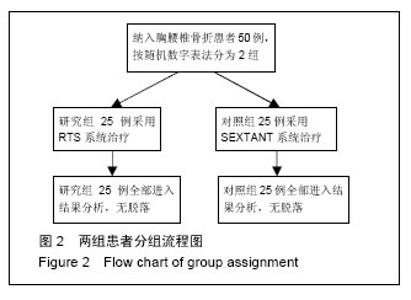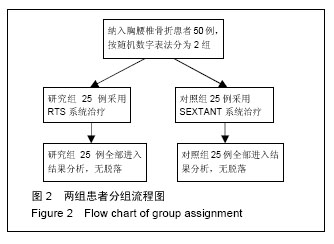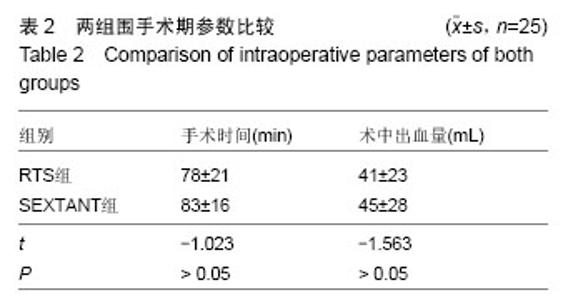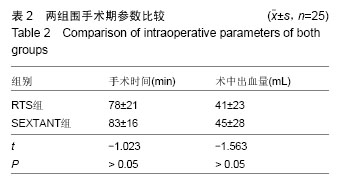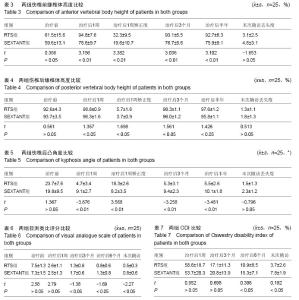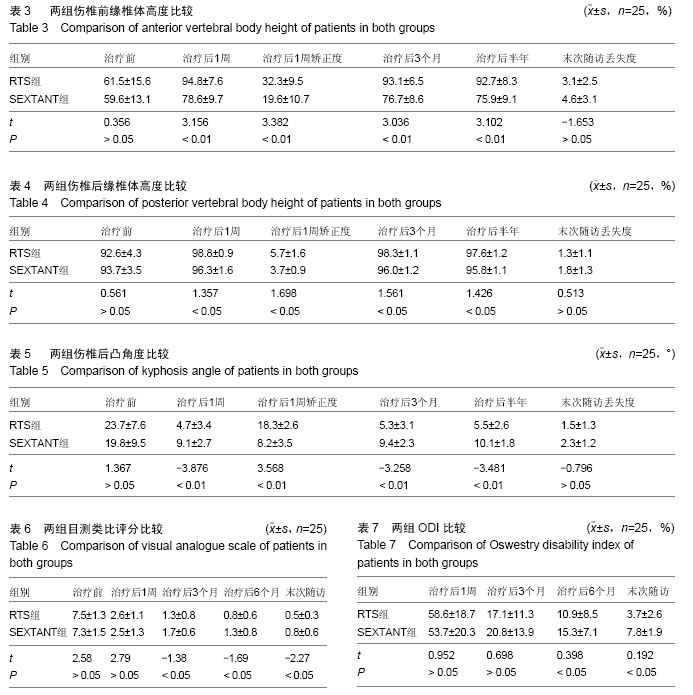Chinese Journal of Tissue Engineering Research ›› 2016, Vol. 20 ›› Issue (22): 3255-3262.doi: 10.3969/j.issn.2095-4344.2016.22.009
Previous Articles Next Articles
RTS versus SEXTANT percutaneous pedicle screw fixation for unstable thoracolumbar fractures under minimally invasive technology: recovery of the height of the vertebral body
Zhao Gang, Zhou Ying-jie, Wang Xu-ke
- Department of Orthopedics, Luoyang Orthopedic Hospital, Luoyang 471002, Henan Province, China
-
Revised:2016-04-19Online:2016-05-27Published:2016-05-27 -
Contact:Zhou Ying-jie, Master’s supervisor, Chief physician, Department of Orthopedics, Luoyang Orthopedic Hospital, Luoyang 471002, Henan Province, China -
About author:Zhao Gang, Master, Associate chief physician, Department of Orthopedics, Luoyang Orthopedic Hospital, Luoyang 471002, Henan Province, China -
Supported by:the Key Academic Leader Fund Training Program of Traditional Chinese Medicine of Henan Province, No. 2100601
CLC Number:
Cite this article
Zhao Gang, Zhou Ying-jie, Wang Xu-ke. RTS versus SEXTANT percutaneous pedicle screw fixation for unstable thoracolumbar fractures under minimally invasive technology: recovery of the height of the vertebral body[J]. Chinese Journal of Tissue Engineering Research, 2016, 20(22): 3255-3262.
share this article
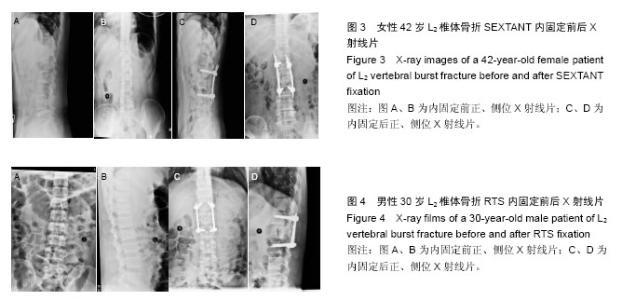
2.5 治疗后功能恢复情况比较 治疗后6个月及末次随访目测类比评分和ODI比较,RTS组和SEXTANT组差异均有显著性意义(P < 0.01),RTS组恢复情况明显优于SEXTANT组,见表6,7。 2.6 典型病例 典型病例1:女性,42岁,高处坠落伤致L2椎体爆裂骨折,行Sextant内固定。随访期间无不良事件发生,见图3。 典型病例2:男性,30岁,高处坠落伤致L2椎体爆裂骨折,行RTS内固定。随访期间无不良事件发生,见图4。 2.7 不良事件 2组患者在术中均未发生椎弓根螺钉误入椎管、神经损伤等并发症,治疗后均未发生术区感染、内固定断裂等并发症。但是RTS组出现1例患者左下侧螺母在术后半年复查时脱出的问题,但患者病椎高度基本无丢失。分析原因认为可能与钉与棒形成钉杆角后螺母所受应力明显增大,导致脱出所致。但此次试验例数相对较少,1例螺母脱出的偶然性相对较大,可能原因较为复杂,需要大宗病例继续观察。"
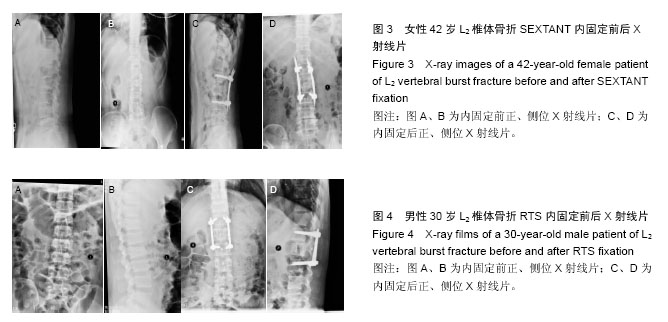
| [1] 李长青,罗刚,周跃,等.新型微创经皮椎弓根螺钉内固定治疗胸腰椎骨折[J].中华创伤杂志,2009,25(6): 522-525.[2] Ni WF, Huang YX, Chi YL, et al.Percutaneous pedicle screw fixation for neurologic intact thoracolumbar burst fractures.J Spinal Disord Tech. 2010;23(8):530-537. [3] 明江华,郑慧锋,赵奇,等.Sextant经皮椎弓根钉棒微创系统治疗胸腰椎骨折:随访评价[J].中国组织工程研究,2013, 17(48):8343-8348.[4] 明江华,郑慧锋,赵奇,等. Sextant经皮椎弓根螺钉固定矫正胸腰椎单节段椎体骨折[J].中国组织工程研究,2014, 18(35):5654-5659.[5] 刘涛,李长青,周跃,等.新型经皮椎弓根螺钉系统的设计与生物力学测试[J]. 中华骨科杂志, 2010, 30(6):594-599.[6] Ma LT, Gong Q, Li T,et al.Relationship between the angle of vertebral screws and spinal lateral angulation after fixation of thoracolumbar fractures via an anterior approach.Genet Mol Res. 2014;13(4):8135-8146.[7] Truszczyńska A, R?pa?a K, ?ukawski S,et al.Evaluation of functional outcomes in individuals 10 years after posterior lumbar interbody fusion with corundum implants and decompression: a comparison of 2 surgical techniques. Med Sci Monit. 2014;20(10): 1400-1406.[8] Masala S,Taglieri A,Chiaravalloti A,et al. Thoraco-lumbar traumatic vertebral fractures augmentation by osteo-conductive and osteo-inductive bone substitute containing strontium-hydroxyapatite: our experience. Neuroradiology. 2014;56(6):459-466.[9] Jackson KL,Yeoman C,Chung WM,et al. Anterior lumbar interbody fusion: two-year results with a modular interbody device. Asian Spine J. 2014;8(5) : 591-598.[10] 王善金,杨明杰,潘杰,等.微创经皮椎弓根螺钉技术应用进展[J].中国矫形外科杂志,2013,21(5):479-481.[11] Kim DY,Lee SH,Chung SK,et al.Comparison of multifidus muscle atrophy and trunk extension muscle strength: percutaneous versus open pedicle screw fixation.Spine. 2005;30:123-129.[12] Rampersaud YR, Annand N, Dekutoski MB. Use of minimally invasive surgical techniques in the management of thoracolumbar trauma: current concepts. Spine. 2006;31(1lS):S96-S102.[13] Hodus DL, Nieuwland R, Boateng KB,et al. Creatine kinase inhibits ADP-induced platelet aggregation.Sci Rep. 2014;4:6551.[14] Behringer M, Montag J, Kilian Y,et al. The repeated bout effect: is the blunted creatine kinase response an effect of an altered enzyme inactivation kinetic? J Sports Med Phys Fitness. 2014;55(12):1431-1437.[15] Meyerzu Schwabedissen HE, Siegmund W, Kroemer HK, et al. Creatine kinase elevation caused by a combination of fluvastatin and telmisartan in a patient heterozygous for the CYP2C9*3 and ABCC2 -24C > T variants: a case report.BMC Res Notes. 2014;7:688.[16] Johnsen SH, Lilleng H, Bekkelund S. Creatine kinase as predictor of blood pressure and hypertension. Is it all about body mass index? A follow-up study of 250 patients. J Clin Hypertens (Greenwich). 2014;16(11): 820-826. [17] Bagai A, Schulte PJ, Granger CB, et al. Prognostic implications of creatine kinase-MB measurements in ST-segment elevation myocardial infarction patients treated with primary percutaneous coronary intervention.Am Heart J. 2014;168(4):503-511. [18] Kato A, Sakakibara H, Tsuboi H. et al. Depressive symptoms of female nursing staff working in stressful environments and their association with serum creatine kinase and lactate dehydrogenase-a preliminary study.Biopsychosoc Med. 2014;8:21. [19] Kim S,Um TH,Cho CR,et al.False-positive elevation of creatine kinase MB mass concentrations caused by macromolecules in a patient who underwent nephrectomy for renal cell carcinoma.Ann Lab Med. 2014;34(5):405-407.[20] Pokora L,Kempa K,Chrapusta SJ,et al. Effects of downhill and uphill exercises of equivalent submaximal intensities on selected blood cytokine levels and blood creatine kinase activity. Biol Sport. 2014;31(3): 173-178.[21] Nnadi E,Manafa P,Okocha E,et al. Evaluation of creatine kinase activity and inorganic phosphate concentration in adult nigerian homozygous and heterozygous hemoglobin phenotypes. Ann Med Health Sci Res. 2014;4(5):697-700.[22] Laoutidis ZG Kioulos KT. Antipsychotic-induced elevation of creatine kinase: a systematic review of the literature and recommendations for the clinical practice. Psychopharmacology. 2014;231(22):4255-4270.[23] Assaker R. Minimal access spinal technologies: state-of-the-art,indications, and techniques. Joint Bone Spine. 2004;71(6):459-469.[24] 汪群,隋福革,汪丽静,等.经皮椎弓根钉棒置入结合椎体成形治疗胸腰椎压缩性骨折[J].中国组织工程研究,2014, 18(17):2716-2721.[25] 刘俊涛,王小勇,黄建军,等.经皮微创椎弓根钉技术与切开复位内固定治疗胸腰椎骨折的疗效[J].中国骨与关节损伤杂志,2016,31(1):71-73.[26] 郭瑛,黄智,李伟,等.经皮经伤椎短节段椎弓根螺钉治疗单节段胸腰段椎体骨折[J].创伤外科杂志,2015,17(6): 493-496.[27] 朱卉敏,张锴,王衡,等.经皮椎弓根螺钉固定同时经伤椎置钉治疗胸腰椎骨折[J].中华解剖与临床杂志,2015,17(6) 515-518.[28] Kim BG, Dan JM, Shin DE.Treatment of thoracolumbar fracture. Asian Spine J. 2015;9(1):133-146.[29] 王放,贺西京.短节段椎弓根钉棒固定治疗无神经损伤胸腰椎骨折对长期生活质量的影响[J].中国骨伤,2015, 28(1):12-16.[30] 邓昭,田伟,袁强,等.术中即时三维导航引导经皮微创椎弓根螺钉内固定治疗颈椎骨折的临床研究[J].中华外科杂志, 2015,65(10):752-756.[31] 顾勇杰,孙韶华,李国庆,等.经皮与经肌间隙椎弓根钉内固定治疗胸腰椎骨折的疗效比较[J].中国骨与关节损伤杂志,2015,30(9):910-913.[32] 刘亮,蔡丰,刘晓东,等.经皮与开放椎弓根螺钉内固定治疗单节段无神经症状胸腰椎骨折的临床对比研究[J].中国骨与关节杂志,2015,14(9):713-716.[33] 张志成,李放,任大江,等.无神经功能障碍胸腰段屈曲牵张型损伤:经皮与开放椎弓根螺钉固定的比较研究[J].中国矫形外科杂志,2015,23(12):1063-1067.[34] 蔡斌,张文捷,张震祥,等.经皮椎弓根钉治疗单椎体A型胸腰椎骨折的临床疗效[J].中国骨与关节损伤杂志,2015, 30(5):456-459.[35] 孔祥清,孟纯阳,张卫红.微创经皮穿刺椎弓根内固定术治疗胸腰椎骨折的临床疗效观察[J].中国矫形外科杂志, 2015,23(8);692-695.[36] 李春,刘艺明,王善松,等.经皮微创椎弓根螺钉固定治疗胸腰段骨折疗效分析[J].颈腰痛杂志,2014,35(5):361-363.[37] 张鹭,吴军,路锟,等.两种手术方式对胸腰段椎体骨折患者术后感染的影响研究[J].中华医院感染学杂志,2015, 25(19):4500-4501.[38] Kim DY,Lee SH,Chung SK,et al. Comparison of multifidus muscle atrophy and trunk extension muscle strength: percutaneous versus open podicle screw fixalion.Spine. 2005;30(1):123-129.[39] 钱济先,纪振钢,高浩然,等.微创经皮并结合伤椎椎弓根螺钉固定治疗胸腰椎骨折[J].中国矫形外科杂志,2013, 21(16):1591-1596.[40] 张伟,李海音,李杰,等.微创减压联合经皮固定与传统开放手术治疗伴神经损害胸腰椎骨折的疗效比较[J].中国脊柱脊髓杂志,2015,25(5):420-426.[41] Gelb D,Ludwig S,Karp JE,et al. Successful treatment of thoracolumbar fractures with short-segment pedicle instrumentation. J Spinal Disord Tech. 2010;23(5): 293-301.[42] 王许可,李长青,王洪伟,等.联合单向及万向椎弓根螺钉经伤椎经皮内固定治疗胸腰椎骨折[J].中华创伤杂志,2013, 29(5):431-437.[43] 周英杰,赵刚,黄孝敏.自旋转撑开椎弓根螺钉系统的生物力学分析[J].中华创伤骨科杂志,2015,17(12): 1073-1077. |
| [1] | Shi Bin, An Jing, Chen Long-gang, Zhang Nan, Tian Ye . Influencing factors for pain after total knee arthroplasty [J]. Chinese Journal of Tissue Engineering Research, 2017, 21(7): 993-997. |
| [2] | Wang Xian-xun. Impact of local compression cryotherapy combined with continuous passive motion on the early functional recovery after total knee arthroplasty [J]. Chinese Journal of Tissue Engineering Research, 2017, 21(7): 998-1003. |
| [3] | Yuan Wei, Zhao Hui, Ding Zhe-ru, Wu Yu-li, Wu Hai-shan, Qian Qi-rong. Association between psychological resilience and acute mental disorders after total knee arthroplasty [J]. Chinese Journal of Tissue Engineering Research, 2017, 21(7): 1015-1019. |
| [4] | Chen Qun-qun, Qiao Rong-qin, Duan Rui-qi, Hu Nian-hong, Li Zhao, Shao Min. Acu-Loc®2 volar distal radius bone plate system for repairing type C fracture of distal radius [J]. Chinese Journal of Tissue Engineering Research, 2017, 21(7): 1025-1030. |
| [5] | Huang Xiang-wang, Liu Hong-zhe. A new low elastic modulus of beta titanium alloy Ti2448 spinal pedicle screw fixation affects thoracic stability: biomechanical analysis [J]. Chinese Journal of Tissue Engineering Research, 2017, 21(7): 1031-1035. |
| [6] | Xie Qiang. Three-dimensional finite element model for biomechanical analysis of stress in knee inversion and external rotation after posterior cruciate ligament rupture [J]. Chinese Journal of Tissue Engineering Research, 2017, 21(7): 1036-1040. |
| [7] | He Ze-dong, Zhao Jing, Chen Liang-yu, Li Ke, Weng Jie. Multilevel finite element analysis on the biological tribology damage of water on bone tissue [J]. Chinese Journal of Tissue Engineering Research, 2017, 21(7): 1041-1045. |
| [8] | Jiang Zi-wei, Huang Feng, Cheng Si-yuan, Zheng Xiao-hui, Sun Shi-dong, Zhao Jing-tao, Cong Hai-chen,Sun Han-qiao, Dong Hang. Design and finite element analysis of digital splint [J]. Chinese Journal of Tissue Engineering Research, 2017, 21(7): 1052-1056. |
| [9] | Wang Fei, Liu Zhi-bin, Tao Hui-ren, Zhang Jian-hua, Li Chang-hong, Cao Qiang, Zheng Jun, Liu Yan-xiong, Qu Xiao-peng. Clinical efficacy of preoperative osteotomy designs using paper-cut technology versus photoshop software for ankylosing spondylitis with kyphosis [J]. Chinese Journal of Tissue Engineering Research, 2017, 21(7): 1057-1063. |
| [10] | Li Hui, Ma Jun-yi, Ma Yuan, Zhu Xu . Establishment of a three-dimensional finite element model of ankylosing spondylitis kyphosis [J]. Chinese Journal of Tissue Engineering Research, 2017, 21(7): 1069-1073. |
| [11] | Ling Guan-han, Ou Zhi-xue, Yao Lan, Wen Li-chun, Wang Guo-xiang, Lin Heng-feng. Establishment of simulating three-dimensional model of China-Japan Friendship Hospital Classification for L type osteonecrosis of the femoral head [J]. Chinese Journal of Tissue Engineering Research, 2017, 21(7): 1074-1079. |
| [12] | Fu Wei-min, Wang Ben-jie. Assessing the degree of necrotic femoral head, and association of blood supply with pathlogical changes: study protocol for a diagnostic animal trial [J]. Chinese Journal of Tissue Engineering Research, 2017, 21(7): 1086-1091. |
| [13] | Zhang Wen-qiang, Ding Qian, Zhang Na. Associations between alpha angle and herniation pit on oblique axial magnetic resonance imaging in asymptomatic hip joints of adults [J]. Chinese Journal of Tissue Engineering Research, 2017, 21(7): 1098-1103. |
| [14] | Sun Xiao-xin1, Zhou Wei2, Zuo Shu-ping3, Liu Hao1, Song Jing-feng1, Liang Chun-yu1. Morphological characteristics for the magnetic resonance imaging assessment of discoid lateral meniscal tears in children [J]. Chinese Journal of Tissue Engineering Research, 2017, 21(7): 1104-1109. |
| [15] | Lin Han-wen, Wen Jun-mao, Huang Chao-yuan, Zhou Chi, Tang Hong-yu. Correlation between the changes in lower limb power line and pain area in the knee osteoarthritis patients: imaging evaluation [J]. Chinese Journal of Tissue Engineering Research, 2017, 21(7): 1110-1114. |
| Viewed | ||||||
|
Full text |
|
|||||
|
Abstract |
|
|||||
